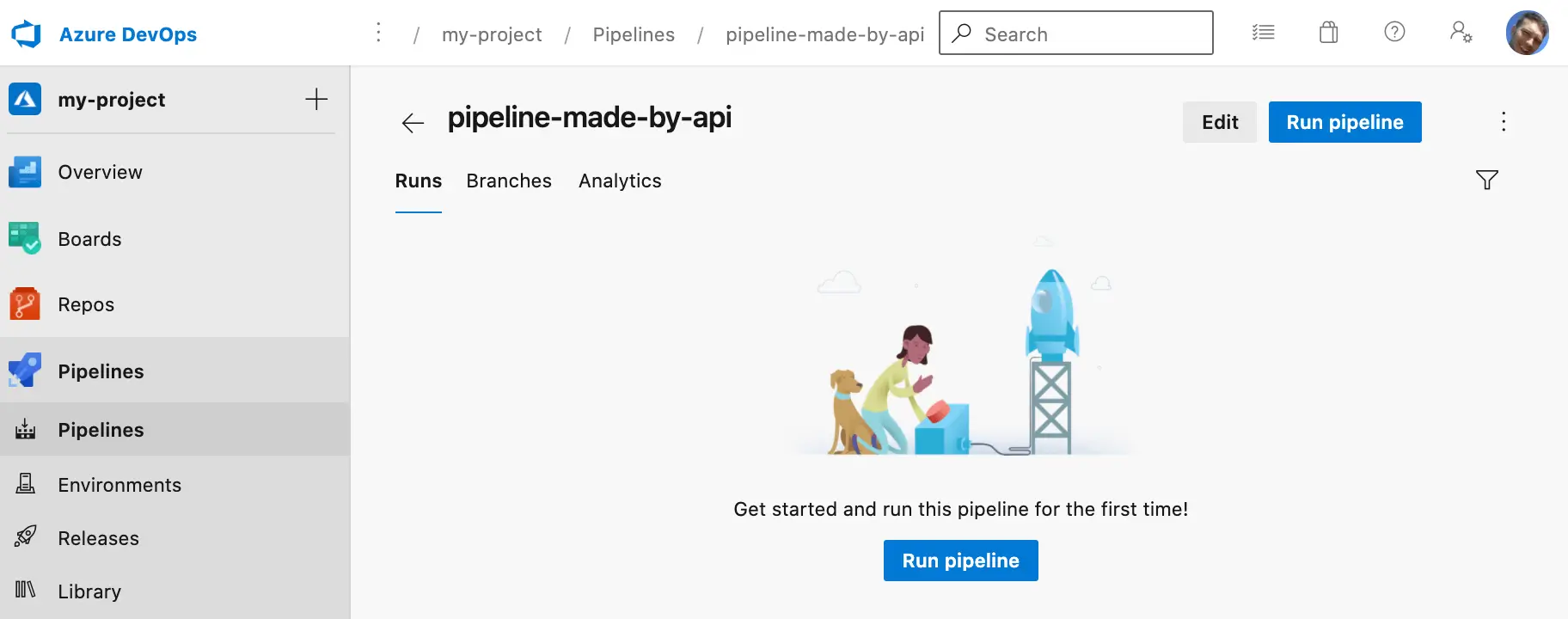Create a Pipeline with the Azure DevOps API
· 2 min read
Creating an Azure Pipeline using the Azure DevOps REST API is possible, but badly documented. This post goes through how to do this.
curling a pipeline
The documentation for creating an Azure Pipeline using the Azure DevOps API is somewhat lacking. However it isn't actually too hard, you just need the recipe.
Here's a curl to make you a pipeline:
curl --user '':'PERSONAL_ACCESS_TOKEN' --header "Content-Type: application/json" --header "Accept:application/json" https://dev.azure.com/organisation-name/sandbox/_apis/pipelines?api-version=6.1-preview.1 -d @makepipeline.json
Looking at the above there's two things you need:
- A personal access token. You can make one of those here: https://dev.azure.com/organisation-name/_usersSettings/tokens (where
organisation-nameis the name of your organisation) - A
makepipeline.jsonfile, which contains the details of the pipeline you want to create:
{
"folder": null,
"name": "pipeline-made-by-api",
"configuration": {
"type": "yaml",
"path": "/azure-pipelines.yml",
"repository": {
"id": "guid-of-repo-id",
"name": "my-repo",
"type": "azureReposGit"
}
}
}
Let's talk through the significant properties above:
folder- can benullif you'd like the pipeline to be created in the root of Pipelines; otherwise provide the folder name. Incidentally anullwill be translated into a value of\\which appears to be the magic value which represents the root.name- your pipeline needs a namepath- this is the path to the yaml pipelines file in the repo. Note we're creating the pipeline itself here; what's actually in the pipeline sits in that file.repository.id- this is the guid that represents the repo you're creating the pipeline for. You can find this out by going to your equivalent https://dev.azure.com/organisation-name/project-name/_settings/repositories (substituting in appropriate values) and looking up your repository there.repository.name- the name of your repo
When you execute your curl you should be returned some JSON along these lines:
{
"_links": {
"self": {
"href": "https://dev.azure.com/organisation-name/2184049d-8bc4-484a-91e6-00fca6b5b19f/_apis/pipelines/975?revision=1"
},
"web": {
"href": "https://dev.azure.com/organisation-name/2184049d-8bc4-484a-91e6-00fca6b5b19f/_build/definition?definitionId=975"
}
},
"configuration": {
"path": "/azure-pipelines.yml",
"repository": {
"id": "9a72560d-1622-4016-93dd-32ac85b96d03",
"type": "azureReposGit"
},
"type": "yaml"
},
"url": "https://dev.azure.com/organisation-name/2184049d-8bc4-484a-91e6-00fca6b5b19f/_apis/pipelines/975?revision=1",
"id": 975,
"revision": 1,
"name": "pipeline-made-by-api",
"folder": "\\"
}
And inside Azure DevOps you'll now have a shiny new pipeline:

